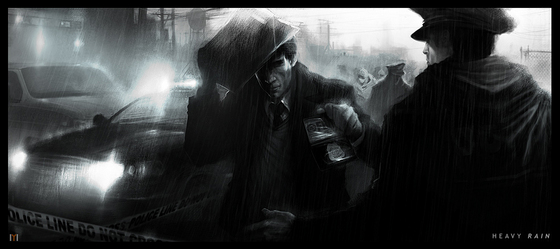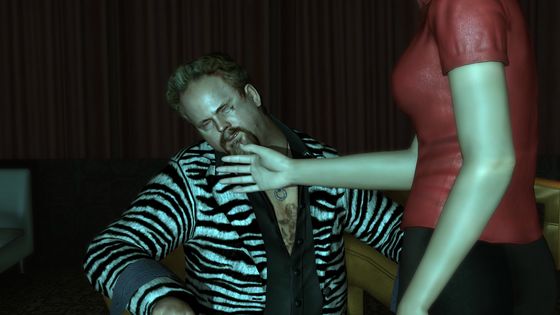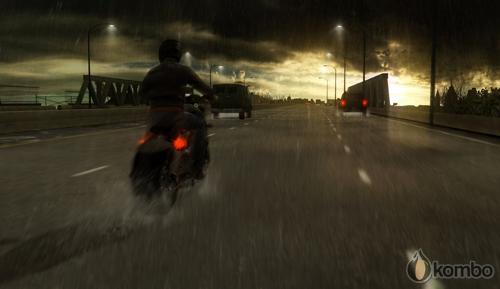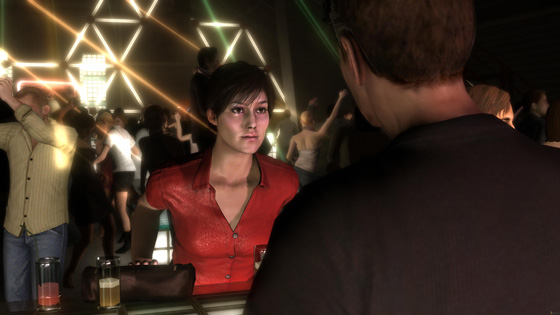Rationale and Authorship (Heavy Rain)
July 27th, 2010

Now that we understand the different roles the player commandeers in a video game, we can begin to understand the rationale behind our choices made in Heavy Rain.
Because of the subject matter, I will obviously be divulging major plot spoilers, so I urge you not to read on if you haven’t already completed Heavy Rain. If you have, however, then please feel free to include your own rationale in the comments section below. Perhaps we will compile the most interesting responses in a separate article if there’s enough interest.
Trial #1
Driving into Head-on Traffic
Being the initial trial, the parameters of the Origami Killer’s twisted game aren’t yet so clear. Like many, I presume, I accepted this trial partly under the assumption that the game wouldn’t hurt me – that so long as I followed the rules, Ethan would remain unscathed. This assumption and the supposition that “hey, it’s a game and I should just play along” overrid the consideration set outlined in the previous article. My assumptions turned out not to be true — whether by my inputs or by design, I don’t know — as I completed the challenge, but flipped the car and could not reach my reward.
Trial #2
The Electricity Plant
Considering the pain Ethan went through in the prior trial, I felt a little uneasy about the electricity plant. You could just tell that things were going to get worse. There are two stages to this trial but only one decision, since you cannot bail out of crawling through the glass-filled chamber. The question is whether you’re willing to walk through the electric minefield. The generators instill a sharp sense of fright and my knee-jerk reaction would have been to steer clear. However, above all else, I wanted to relieve Ethan of this burden and I knew that irrespective of me, he would have seriously contemplated this decision. I don’t know very much about power stations and while venturing ahead would obviously put Ethan at high risk, this unfamiliarity with the danger allowed me the waver the ethical dilemma of any unfortunate consequences. As such, I made my way through, but misread the signs and nearly killed myself, prompting Ethan to automatically forfeit.
Trial #3
Cutting off the End of Your Finger
The third trial will always stick in my mind as its the most savage of Heavy Rain‘s emotional string-pulling, and the first time a game made me feel immense frustration and self-hate. You’re situated in a vacant room and asked to cut off the end of your finger in front of the camera with any of the utensils available in the room. The stress is compounded by the fact that you will fail to cut your finger from the bone on your first attempt and have to fight the agony in a second attempt.
This decision prompted a primal sense of rationality, so I was quick to make and execute on my decision. I decided to go ahead with it. There was, of course, some conflict. As a viewer and a director, I knew that I would be putting Ethan in a world of agony that he would never wish to experience and I would certainly condemn myself for watching, let alone participating in. The chips were stacked against me though; I’d failed the last two trials which meant that Shaun would drown to death if I didn’t produce results. There was nothing in my way this time. I could get a tangible result, all I needed was to go through with the torture. Furthermore, having gone through this much pain already, I imagine that cutting off a part of a finger would be within Ethan’s threshold of pain. I acted quickly and chose the first tool I could find: a pair of scissors. I didn’t even look for anything else; who knows, the game might go back on its rules, but I needed to ensure a win here.
Trial #4
Killing the Drug Dealer
Would you kill someone to save someone else? The rational answer is “no.” It doesn’t make sense to forfeit someone else’s life for the potential of saving another’s. Heavy Rain played on these assumptions though. The target is a drug dealer who, when spurred, tried to end your life. In which case, killing a violent drug dealer can almost be regarded as an act of community service; if caught, Ethan could vouch for self-defense. Another fold to throw your deliberation occurs right before you make the decision, when the drug dealer quivers that he too is a father and pleads against his potential retribution.
I chose in favor of my understanding of Ethan, who I believed wouldn’t go so far as to kill someone else. I made this decision before I even went to the house as I believed quite strongly in my interpretation of the avatar. I am pleased with the decision I made.
Trial #5
Drinking the Vial
The final trial is a fitting apotheosis to the game: would you sacrifice your own life for someone else’s? I had a feeling that it would all come down to this, but the means at which it does (drinking a vial of poison allowing enough time for you to free your son) removes any potential distraction; it all comes down to principles.
I chose not to drink the vial. I figured that given my completion of only one trial, it was likely that Shaun would die and that it would be better to let Ethan survive and live with Madison (who can counsel him) as opposed to letting Shaun survive but live with the anguish of watching his father die. In this way, it was better for Ethan as he had an emotional attachment which could aid him if his son did in fact die in the rain. This decision was universal amongst the roles. It is an ethically sound decision that I wanted to see happen and believed that Ethan would too.
End Game
My endgame hinged on my final decision before I left the hospital as Madison: the orchid in the hallway. This opened the way to the house of the Origami Killer, which I successfully escaped from. I also guessed the proper password for the address of Shaun’s whereabouts which lead to the final confrontation. I couldn’t solve the crime as Jayden, so it came down to a battle between Ethan and the Origami killer which I won. In the end, Madison, Ethan and Shaun move into a new apartment together and Jayden retires.
Conclusion
There you have it, the reasoning behind and outcomes of my Heavy Rain adventure. Despite failing terribly at points throughout the game, I succeeded in the end. What about you? What was your rationale and how did you manage your different roles in deciding on your actions? Please let us know through the comments.
Player Roles and Heavy Rain
July 17th, 2010

Heavy Rain‘s core conceit is the question: How far would you go for the one you love? Those who have played Heavy Rain will know that this question is most obviously evident in the trials undertaken by the lead protagonist Ethan Mars, but it’s also one which ripples into the tangled stories of the other cast members. To follow through on this question, Heavy Rain establishes relatable characters (through menial, day-to-day context) and puts them in extreme situations which are constructed to press this question. These situations bring the player’s differing roles of agency to the forefront. In many respects, these sequences create deliberation between the different parties that the player occupies, which is why players agonize over their decisions; they can’t get everyone to agree and are forced into a tough compromise. Here is breakdown of the player’s roles of agency and the respective questions asked to each player role at each trial, using Ethan as the model:
Co-author
If I were Ethan, what would I do?
(based on the player’s understanding of the avatar’s principles combined with their own)
Avatar
Within my inferred understanding of Ethan’s character, what do I think he would do?
(based on the player’s understanding of the avatar’s principles, independent of their own)
Viewer
What do I want to see happen, what is most entertaining?
(based on the player’s compulsion)
Director
What is the responsible action, the right thing to do?
(based on the player’s ethical interpretation)
When we play video games, we don’t just act upon our own whim, but rather our actions are influenced by the different ways we engage with the game. When I take the role of Solid Snake inMetal Gear Solid, I share this role with his—the avatar’s—doctrine. I know that Snake is cunning, inventive and stealthy, so my actions are mapped to my understanding of what it means in inhabit this character. I, therefore, have the freedom to act within my own interpretation of the character. This is called co-authorship.
The avatar is also their own character, so they can exist independently of the player. As mentioned in the previous article, there are times when we are not in control of the avatar. For instance, in cut scenes. In these instances the avatar is in their own frame of mind, without our influence, which affects how we think respond to the second question. Another way to think of this is, “if there was a cut scene here, what would the avatar most likely do?”
Different types of games emphasize different roles. Open world action games such as Just Cause 2or Saints Row often feature “empty” avatars or at the very least avatars bent on fun and mayhem, because these games are viewer-centric. That is, the player’s actions are based around whatever seems fun or entertaining. Injecting prescribed character into these avatars works against the impetus of enjoyment as it supposes the player model their behavior around the predefined persona of the avatar. This was apparent in Grand Theft Auto IV, where some players felt uncomfortable with simulating the murder and destruction which the previous GTA games reveled in. Because Niko was a responsible, good-willed avatar such actions would contradict his innocent persona.
The director is the Jiminy Cricket-esque conscience which puts ethical considerations into focus. Normally, most games are ethically sound, but occasional titles, like Heavy Rain, force the player into moments of moral and ethical deliberation. It’s here where we must consider our role as the director of the experience.
All character-based games feature co-authorship and the avatar’s prescribed perspective. In video games the player needs a body to inhibit and a base level persona to model their behavior on; these are basic requisites that determine play. The presence of the other two roles depends on the subject matter of the game. What is most fascinating about Heavy Rain is the way these moments make the player conscious of their multiple identities within the interactive medium. We’re not just making one choice, we’re making many and under pressure.
Design Discussions: Heavy Rain Vs. The People – Forfeiting Control to the Director (A footnote)
July 13th, 2010

[‘Design Discussions’ is a new, regular-occurring column for Kombo by Daniel Johnson, explicating on elements of game design through a case study approach. This piece is a footnote to the initial column Deconstructing the Video Game: Three Pillars of Design for Interactive Drama (Heavy Rain), so it is recommended that you read the prior article first.]
With contextual interactivity, players are somewhat at the mercy of the director. The director is the person who assigns all points of interactivity and the time frame in which they can be initiated, rather than the player. This system coerces players into cooperating with the narrative, and although a handful of people seem to outright refuse this system, it’s a far more persuasive, even-handed approach towards director control than the alternatives. Let us assess the issue of persuasion with traditional video game narrative techniques and conclude with a contrast to Heavy Rain.
Complete Control – In-game Narrative
Broadly speaking, in recent years, in-game narrative has proven to be a very organic and effective way to deliver supplementary narrative and contextualisation. The sound logs in Dead Space which play over gameplay are one such example commonly used throughout the industry (also seeBatman: Arkham Asylum and Bioshock). Despite the successes in conveying minor information, in-game narration is an unreliable way of delivering important information to the player as it only leads the horse to water. As anyone who has ever played with the gravity gun while sitting through one of Alyx’s talky scenes in Half-life 2 can attest, there’s no guarantee that players will cooperate or pay attention, particularly when they’re given the liberty of retaining their regular ability set.
No Control – Cutscenes
So how does one make the player cooperate? By taking complete control away through the form of a cutscene. Cutscenes are embroiled in their own infamy in that they can feel as though the designer is taking over, and in some cases, dominating the interactive experience. Players can get particularly antsy during unskippable or overly long cutscenes, which is why they must be well implemented such as a reward for an extended period of play or to conclude/open a chapter or scene. Even though cutscenes are loathed by some, they are an infallible means of control for developers to steer the narrative.
Partial Control – “Disabled Scenes”
A recent hybrid of the cutscene and in-game narrative (perhaps slanting closer to the latter), are the scenes where the majority of the player’s mechanics are disabled besides those which allow the player to observe (walking, camera movement). Batman: Arkham Asylum‘s introduction scene did this particularly well as Batman and company wheeled a bound Joker into Arkham Asylum, giving air time to the Joker’s menace. These scenes walk the line between the two other techniques.
Conclusion
The problem with these techniques is that it creates rifts of uneven control. One minute you’re playing the game, maybe absorbing some in-game narrative on the side, then you’re passively taking part in an interactive cutscene, which prompts a cutscene with no control whatsoever and then you’re free to keep playing. The gears of interactivity are constantly switched back and forth that inevitably creates a consciousness which removes the player from the experience.

In Heavy Rain, these bumps are smoothed out and the level of control remains constant throughout. There are scenes where you can walk around and explore, and scenes which are closer to interactive cutscenes, yet the disparity between the two is minimal. Heavy Rain also trains the player to always be ready for action from the beginning which allows the switch to be more seamless. This is all very similar to the principles behind Dead Space‘s narrative (the in-game HUD and narrative) where breaks in immersion are avoided. Because the level of control remains consistent, Heavy Rain is capable of creating narrative experiences which are highly immersive, but also avoids the contrived nature of games like Dead Space.



 Game Design Companion: A Critical Analysis of Wario Land 4 - $7.99
Game Design Companion: A Critical Analysis of Wario Land 4 - $7.99 Level Design: Processes and Experiences
Level Design: Processes and Experiences Speed Boost: The Hidden Secrets Behind Arcade Racing Design - $5.99
Speed Boost: The Hidden Secrets Behind Arcade Racing Design - $5.99 Adventures in Games Analysis: Volume I - $5.99
Adventures in Games Analysis: Volume I - $5.99







